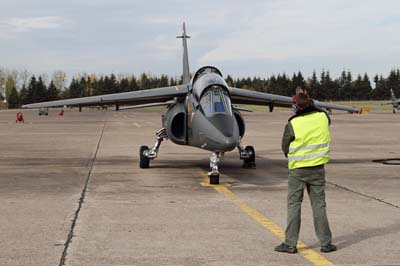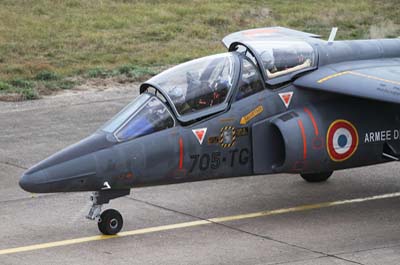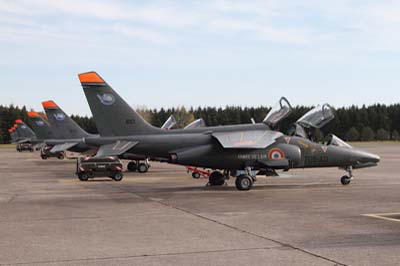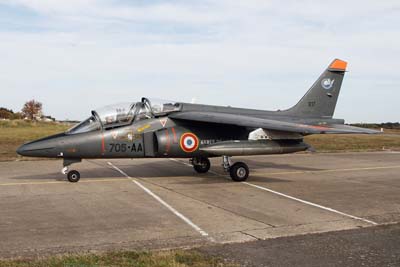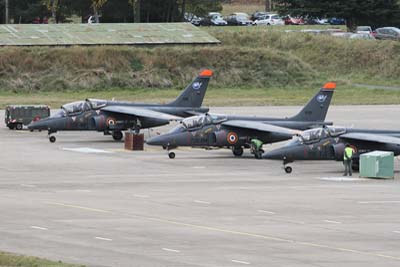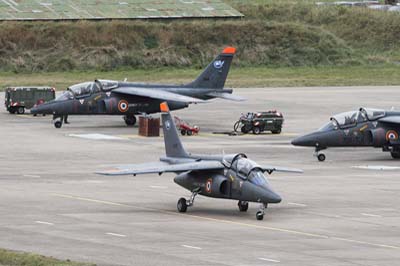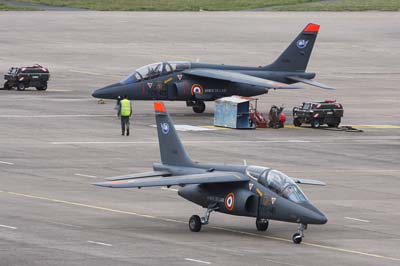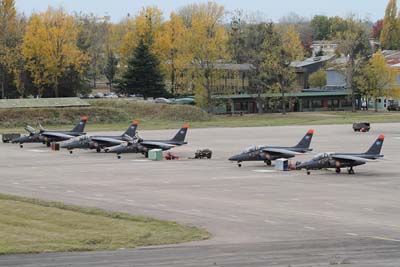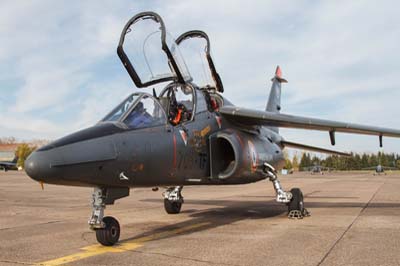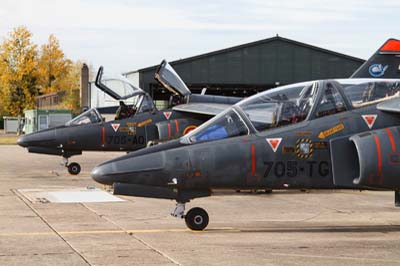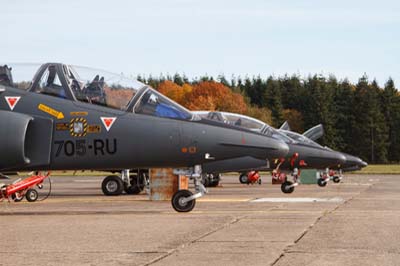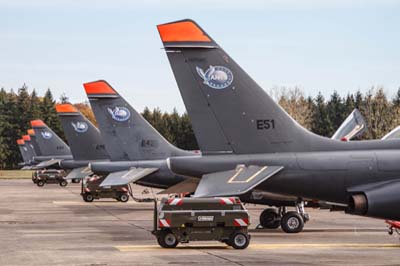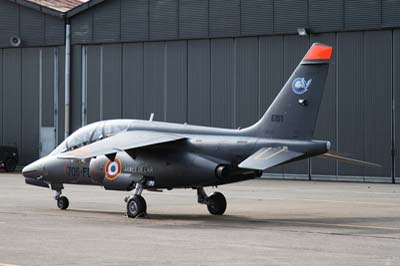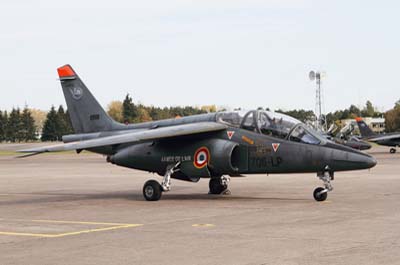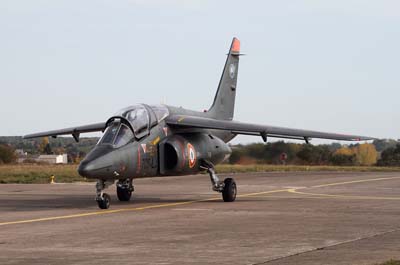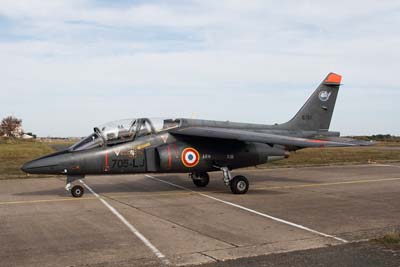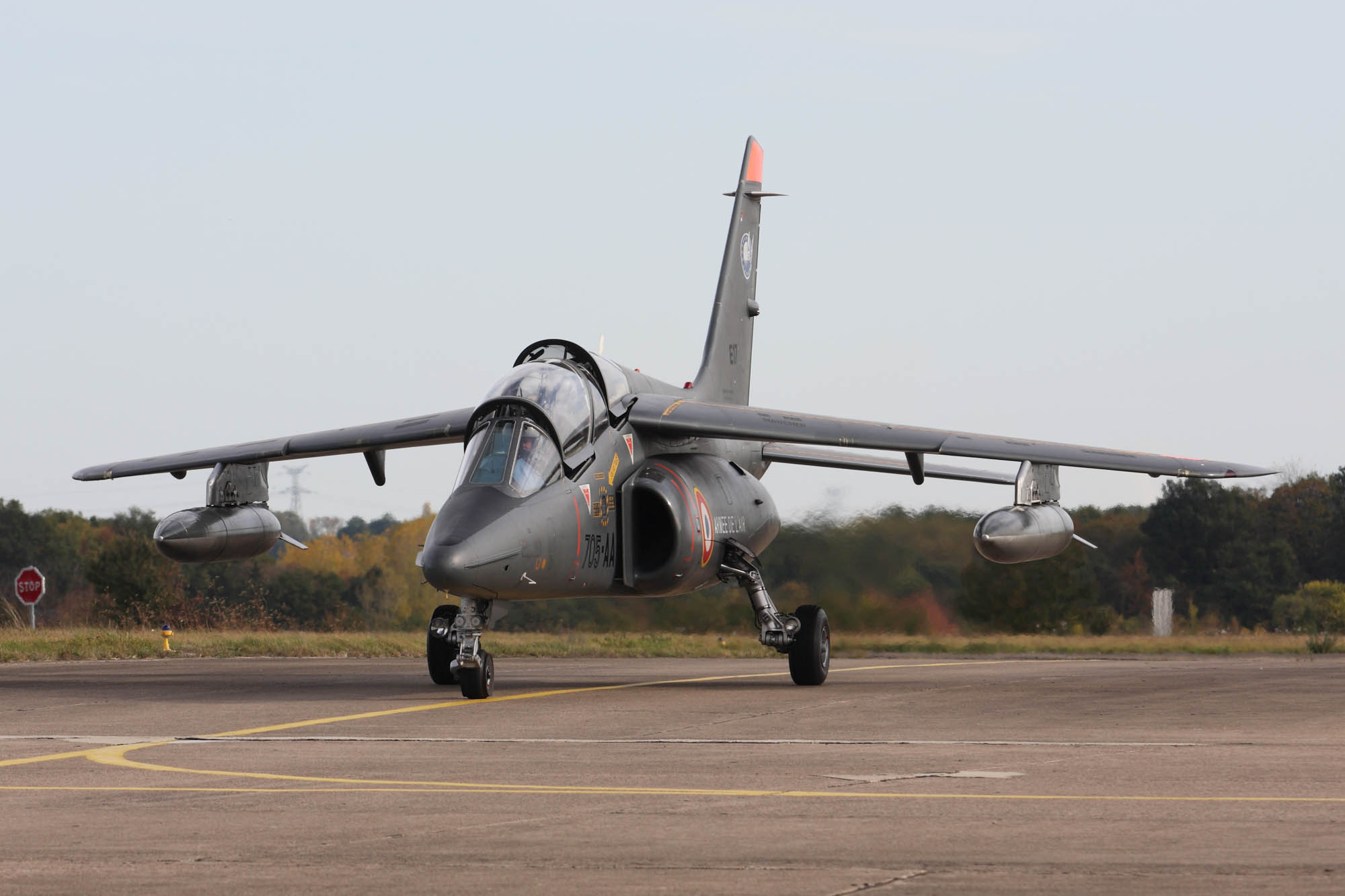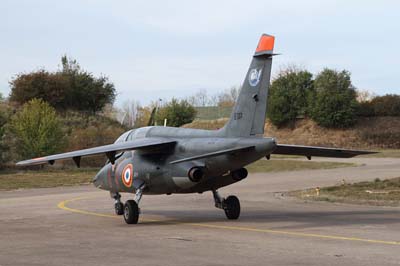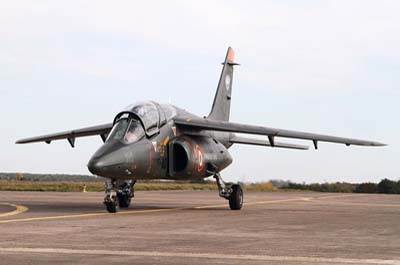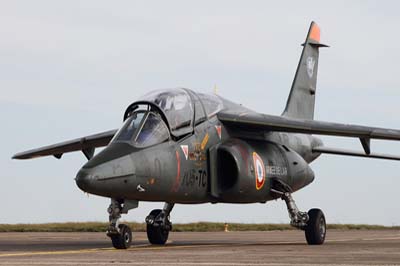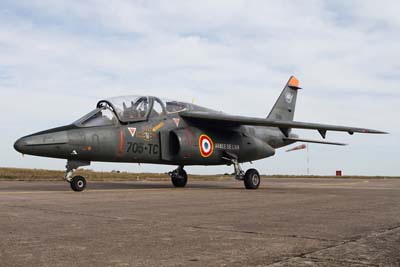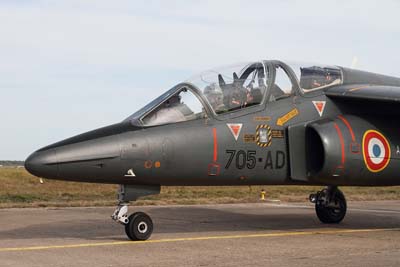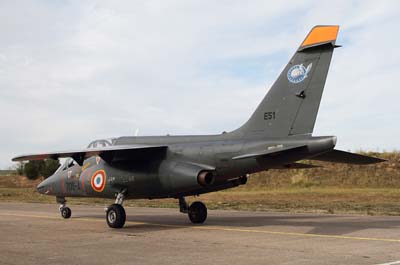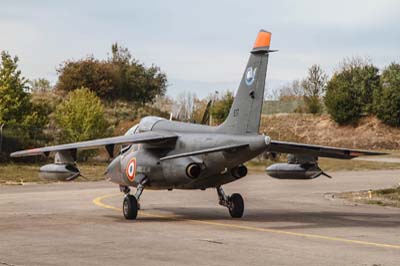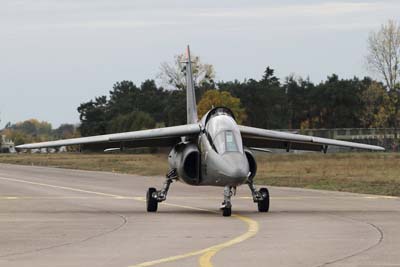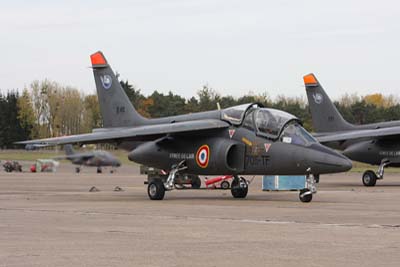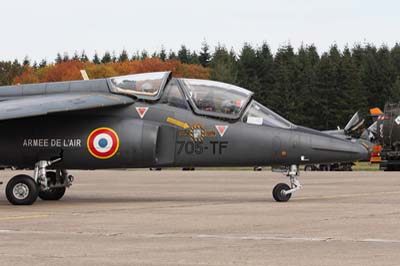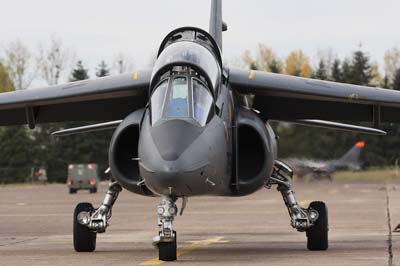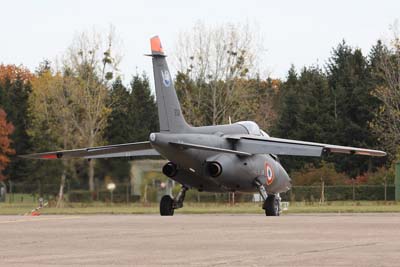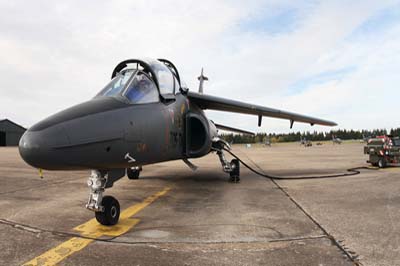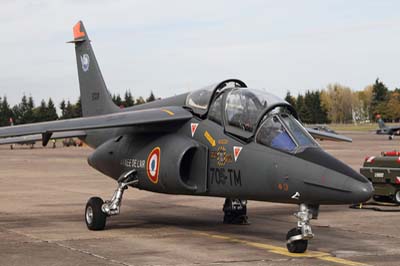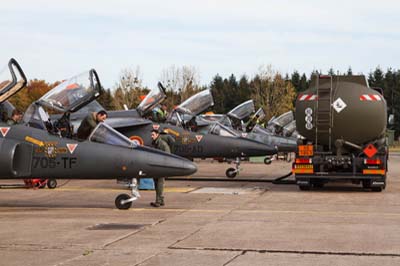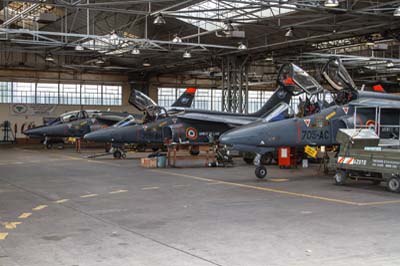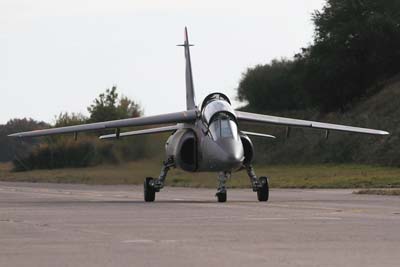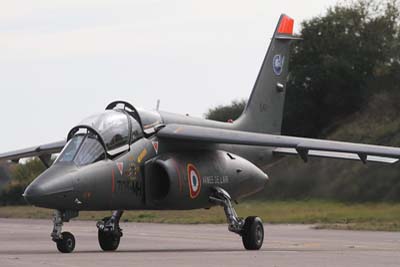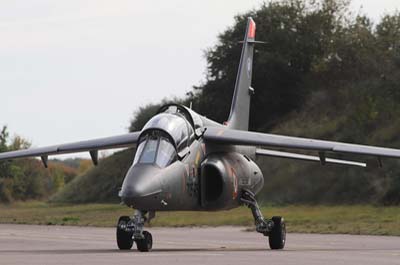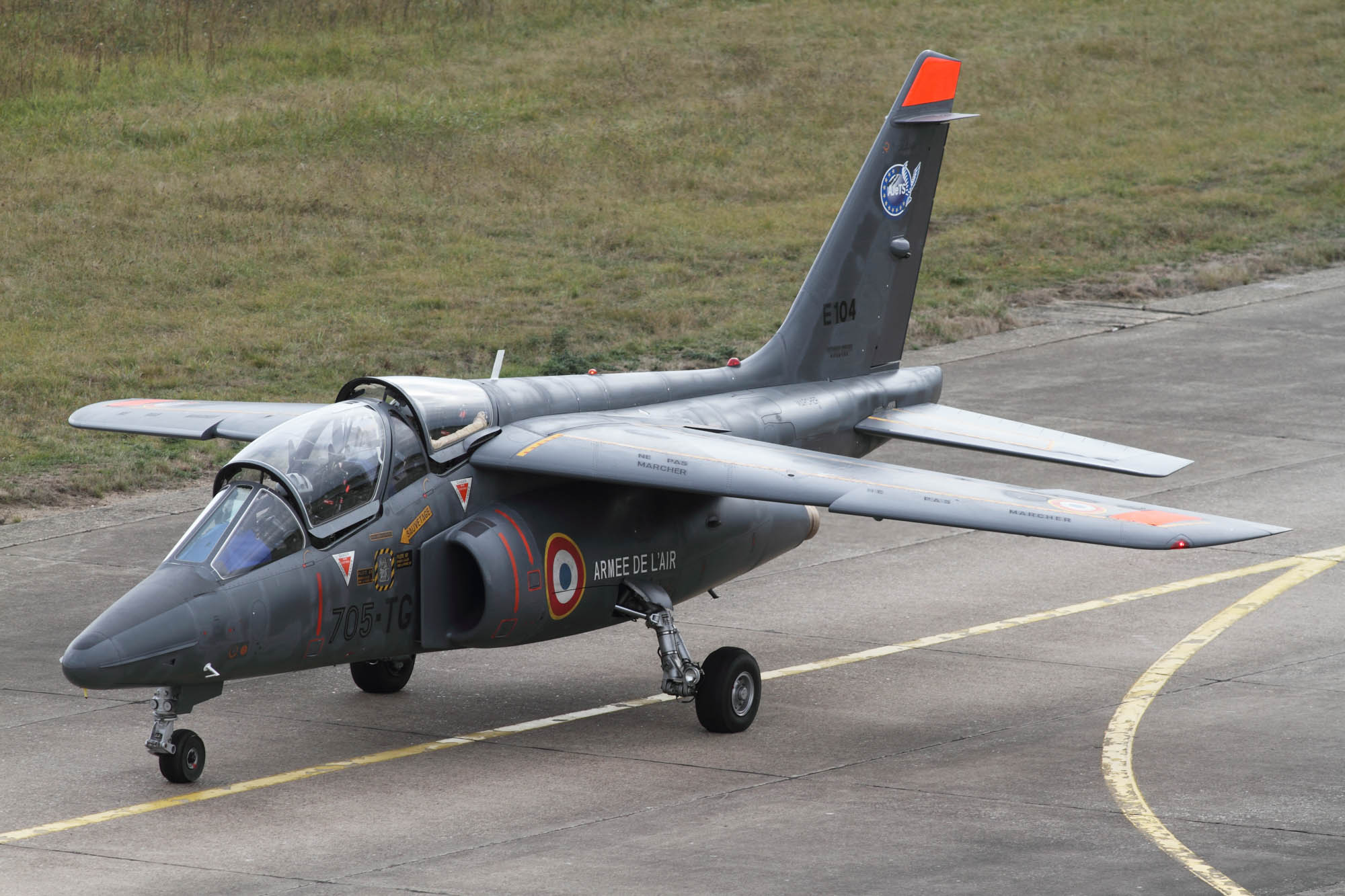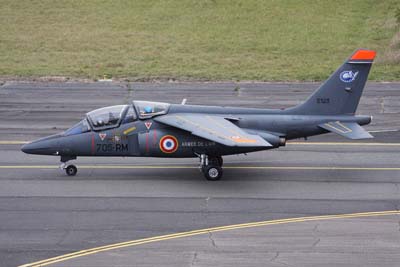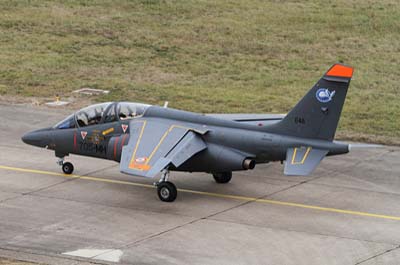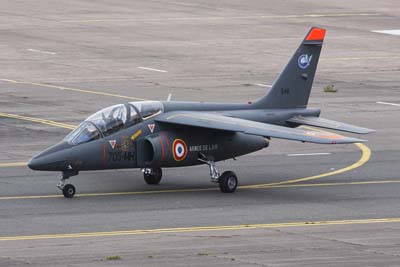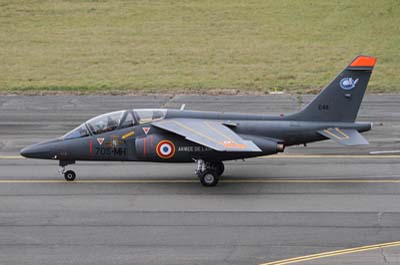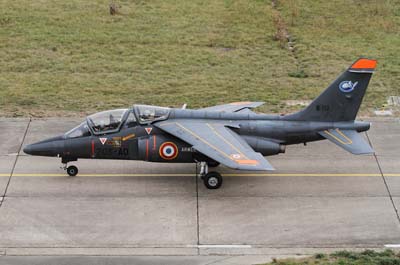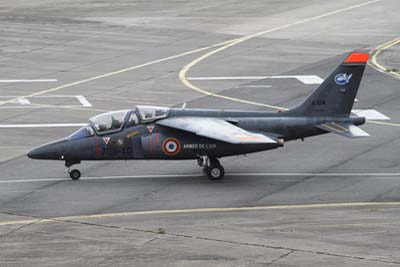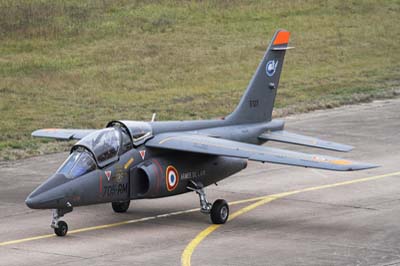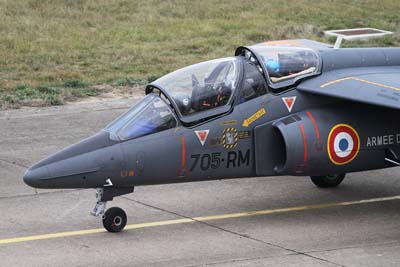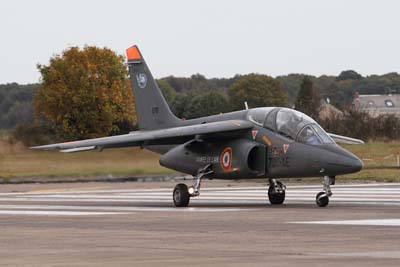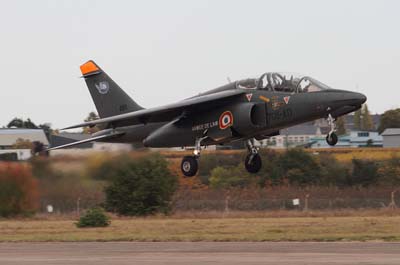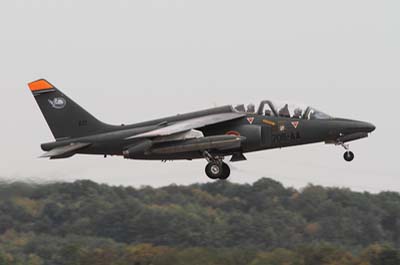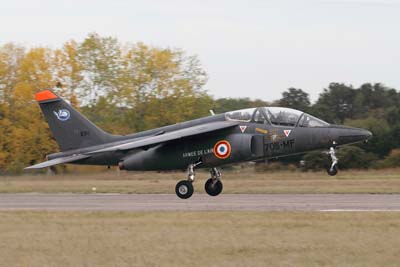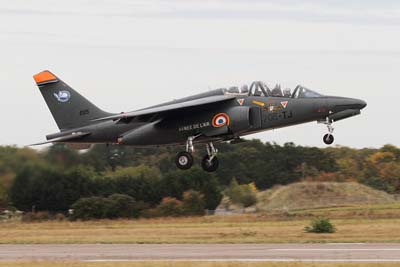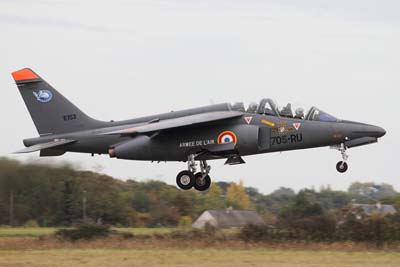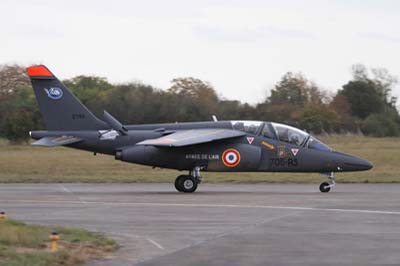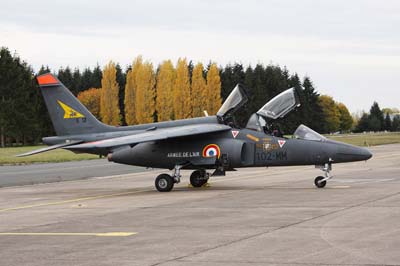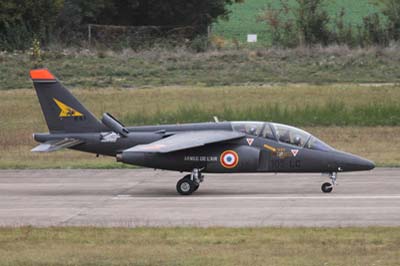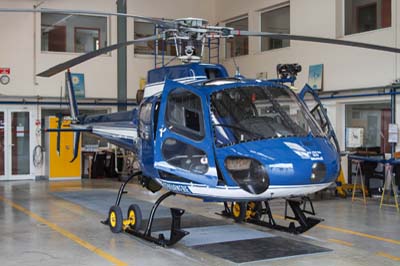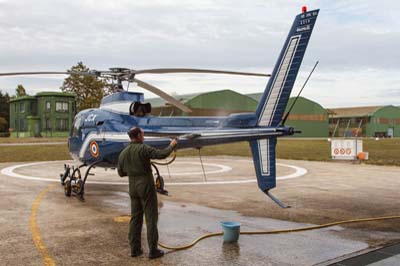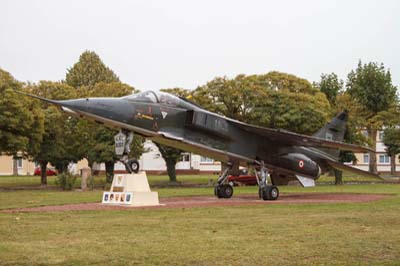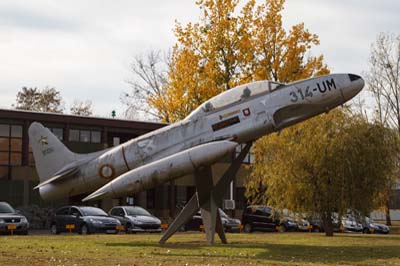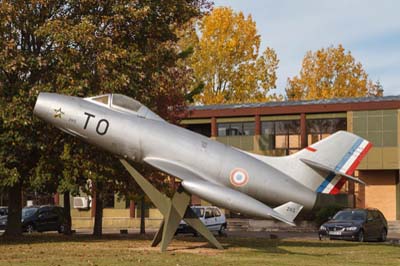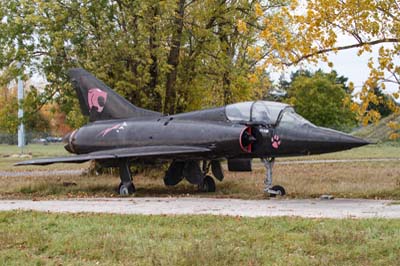50 years of Pilot Training at Tours
Advanced Jet Training School (AJeTS)
Ecole de l'Aviation de Chasse (EAC 00.314)
Base Aérienne 705 Tours-St.Symphorien
October 2011
|
In 2011 Ecole de l'Aviation de Chasse (EAC 00.314) commemorated 50 years of pilot training at Base Aérienne 705 (BA 705) Tours-St. Symphorien and home of the Advanced Jet Training School (AJeTS). In 1961 EAC 314 arrived at Tours; however the unit can trace its history back to 1943 when it was formed at Marrakech moving a year later to Meknès also in Morocco (formally French Morocco). Here the unit adopted the name of Christian Martell the charismatic hero of the free French Air forces. Initially allocated the Curtiss H.75A Hawk, Dewoitine 520 and Douglas A-24 Dauntless they were re-equipped in 1944 with the Hawker Hurricane Mark II S, Curtiss P40 Kittyhawk, Bell P39 Airacobra, Republic P-47D Thunderbolt and Supermarine Spitfire Mark V.
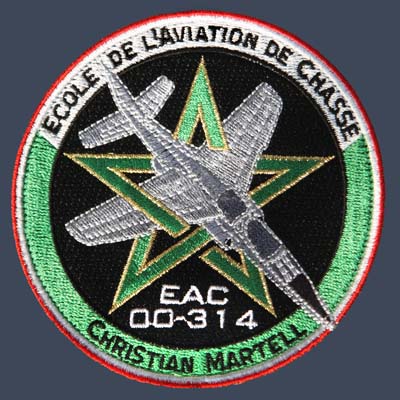
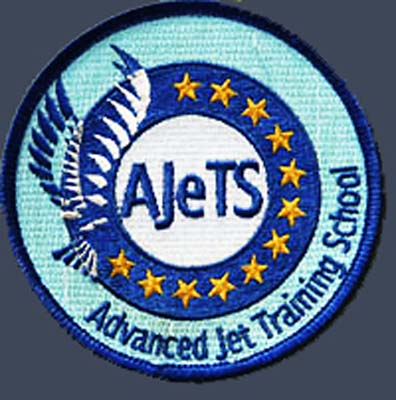 The first jets arrive
The first jets arrive
In 1951 EAC 314 received its first jets the Lockheed T-33A Shooting Star later supplemented with the Dassault MD-450 Ouragan (1957 to 1962) and the Dassault Mystère IV (1961 to 1973). The T-33’s however outlasted the French built jets and was not withdrawn until 1981 after 30 years of service. May 4, 1979 saw the arrival of the first Dassault-Bréguet Alpha Jet E ‘Ecole’. The Dassault/Dornier Alpha Jet is a light attack and advanced jet trainer which was co-manufactured by Dornier of Germany and Dassault-Bréguet of France, the first flight having taken place in 1978.
Lt Col Julien Moreau is currently Deputy AJets Commander (DO) and in 2012 is due to become AJeTS Commanding Officer (CO) of BA 705. Lt Col Moreau had joined the French Air Force Academy in 1995 progressing to Colmar air base (BA 132) to fly the Dassault Mirage F.1CT in the ground attack role. In seven years he had clocked up 1,500 hours and he estimates between 50% and 70% were at low-level. With regular tours of duty to North Africa he has considerable experience, particularly in the Close Air Support (CAS) role. His valuable experience saw him posted to the Allied Command Operations Tactical Leadership Programme (ACO TLP) for three years, two years at Florennes in Belgium and one year at Albacete from July 2009 when the TLP was transferred to Spain. During this time he maintained his currency on the Mirage F.1CR in the reconnaissance role.
AJeTS comprises two squadrons (1er et 2e Escadron d’instruction en vol ) using a pool of 40 Alpha Jet E. Currently there are 45 Instructor Pilots (IP) at AJeTS including one from 11 Squadron of the Belgian Air Component (COMOPSAIR). Following a review of its advanced jet training program COMOPSAIR decided to send its students from 2004 to AJeTS at Tours and Cazaux where its own Alpha Jets are now based. Around six to nine students from Belgium attend each course at Tours, French and Belgian IP’s train each other’s students.
|
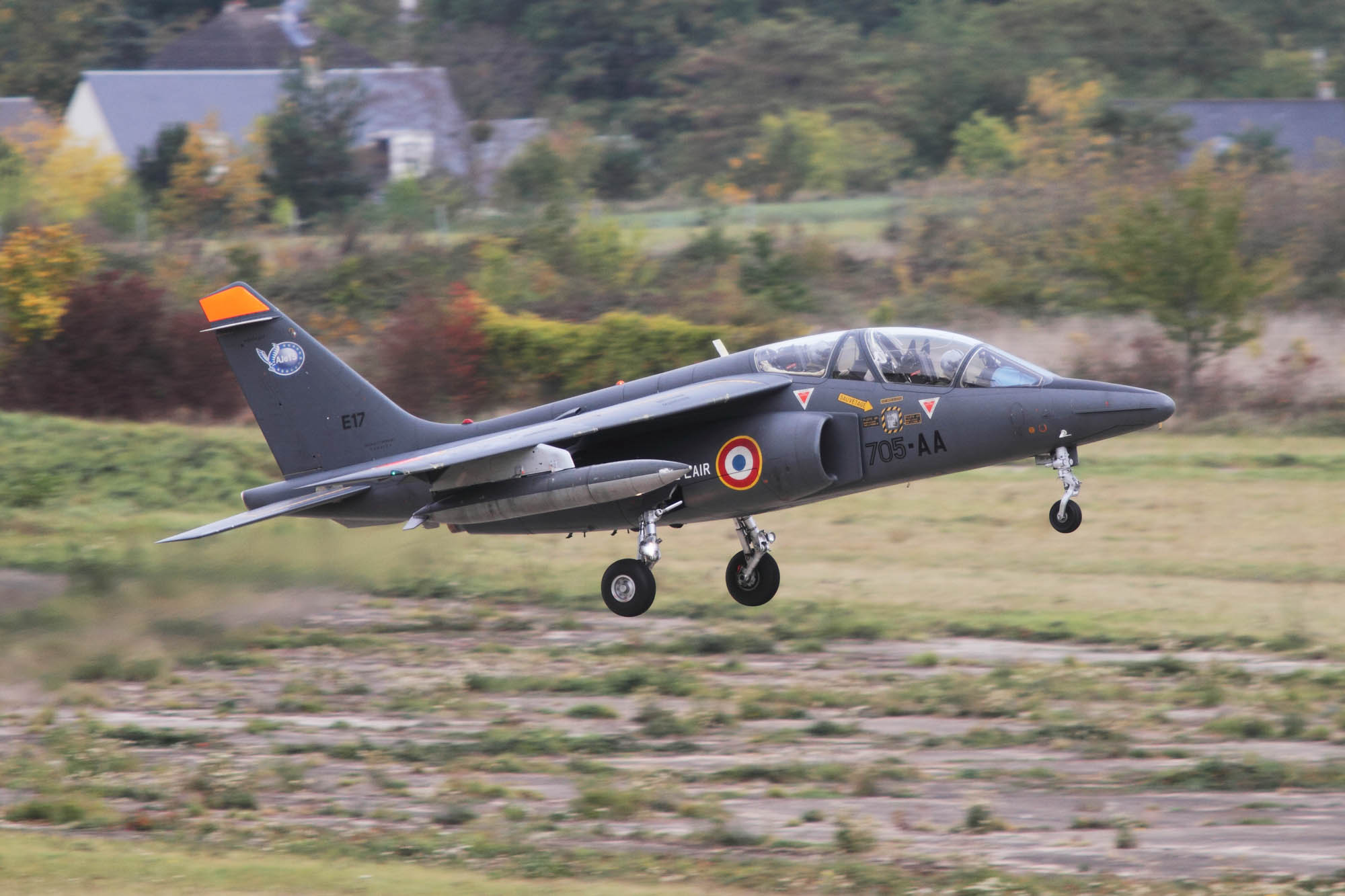 |
| Alpha Jet E (E17 '705-AA') departing Tours, with the old runway in the background, shot from the Tower |
Advanced jet training at Tours
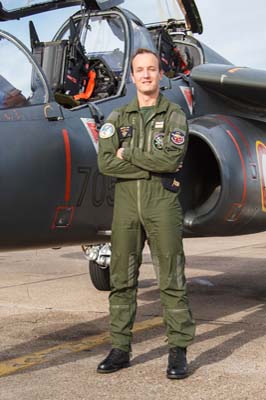 AJeTS runs two main courses running in tandem; one is for 45 student pilots and the other is for 15 trainee Weapons System Officers (WSO) or ‘wizzo’, the courses last between six and seven months. Last year they delivered 35 students with wings and 13 WSO’s.
AJeTS runs two main courses running in tandem; one is for 45 student pilots and the other is for 15 trainee Weapons System Officers (WSO) or ‘wizzo’, the courses last between six and seven months. Last year they delivered 35 students with wings and 13 WSO’s.
The pilot training course consists of 66 sorties which are designed to progressively get harder as they fly nearly 100 hours. Students arrive and attend ground instruction classes for two to three weeks before flying commences. During basic flying training module each student is paired with an IP for the first four or five flights to help build their confidence in the early stages of the course. Initially they will be taught general flying, aerobatics and how to handle aircraft failures. The first four sorties are at just 360 knots this is because before arriving at Tours student pilots will have flown the Grob G120 at only 150 knots and the WSO’s on the Jodel D.140 at 110 knots. During the basic phase students are shown how to stay on track and to leave and get back on track. After around 15 hours of flying they will have two solo flights.
The students are now ready for navigational training module most of these 13 sorties are flown at 420 knots, later they fly at 450 knots when attacking targets. Crew dialogue and co-operation is introduced with fuel management and Global Positioning System (GPS) for navigation. During the basic flying module the IP will not say anything unless asked and will only take control if the student is going to hit the ground.
Preparing a back-seater
The WSO course is divided in to three modules; Basic, Advanced and Combat. 22 students divided between the two squadrons at AJeTS are split into four classes which run in parallel. Flights for student WSO’s get progressively harder increasing mission complexity by one step each time. Major Alexandre Rey, Commander 1st Squadron; “For the students each flight is a challenge. Around 10% to 15% of students are not able to reach the end of the module”.
The Basic module requires the student to navigate without using any systems only by following the map and ground. The Advanced module uses same methods but introduces some technical situations including some time gates, enemy lines, friendly lines and up to two targets. The student is pushed a stage further when in the Combat module they use the GPS and complexity increases as flight management becomes more technical. The WSO program consists of almost 50 sorties and lasts around six to seven months, it runs continuously throughout the year.
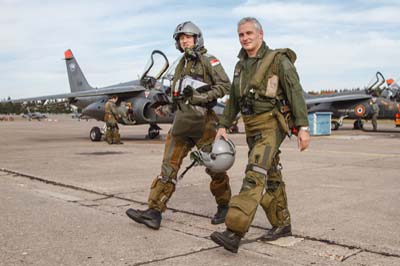 Safety is paramount
Safety is paramount
At every stage of a student’s training safety is the dominant element. An early morning weather briefing is conducted for all students flying that day, IP’s and the commanders gather in the main briefing hall. Students are informed of the days landing procedures and reminded of basic things such as when to adjust throttle and deploy flaps. One student is asked to stand up front for a potential mechanical problem to be thrown at him. His detailed answer should explain all the corresponding safety procedures.
The student’s IP for the day will go through a mission overview 30 minutes before the ‘step’ to the jet, discussing the weather and the mission in detail. Out to the aircraft and 30 minutes is allocated for pre-flight checks.
Planning low-level training sorties
The weather briefing will dictate which areas if any are available for low-level flying. The advanced student may have to prepare to attack two targets. The task for each target could be to bomb, to photograph or just over fly it. At the beginning of the course the IP will explain how to reach the target; students are not given a time they just have to learn to find the target. Later they may be told for example that the run in will be one minute and 30 seconds starting from an initial point short of the target. During the Advanced module they are given timings they have to keep. To further add to the complexity of later missions, students will be given an aircraft failure along the route and a diversion exercise must be exercised. They have to think where this failure maybe and plan where to divert to. One hour 45 minutes is allocated to the student for planning their sorties. Mission planning software is utilised by the students, here the flight track or route is entered by clicking points on a large scale digital map. After keying in additional details of the mission such as; speeds, diversion airfields and targets the mission data is download to a GPS unit which is taken out to the aircraft for the sortie.
|
Left to right: Alpha Jet pilots will test their brakes before taxiing out for take-off. Students initially find it challenging to control the Alpha Jet on the ground as it turns left and right by touching the respective brake, the giveaway to the amusement of the groundcrew is an odd 'snaking' effect when a student taxis out for the first time.
Student Weapons Systems Officers in the back seat and cover the canopy with a curtain to ensure they can navigate by their instruments only and not look out of the canopy. The stowed curtain can be seen around the rear canopy.
Around 40 Alpha Jets are based at Tours, they are pooled between 1er and 2e Escadron d'instruction en vol (EIV). The Standards and Evaluation Squadron which also use these aircraft became known as STANEVAL 4/11 'Jura' on August 20, 2011 taking on the traditions of SPA 161sphinx'.
The Alpha Jet E can be fitted with drop tanks to extend its duration to one hour 30 minutes and enabling 40 minutes for low-level navigation and aircraft handling training exercises. |
High-Low-High
During the navigational training phase high-low-high profile sorties are flown, this is where the student departs high to later descend to low-level over an airfield en-route to a target before climbing out of low level for a high level transit to return to base (RTB). IP Major Xavier Hirschauer described a High-Low-High sortie he was about to instruct on; “We are flying on a mixed profile, departing high before descending down with another airfield to perform low-level navigation behind simulated enemy lines before an RTB at medium or high level depending on fuel. This is to combine different types of navigation with high and low-level flight to perform a strike. Students will deal with technical situations such as the entry gates and the simulated threats in the area such as an airfield”.
The aircraft for this sortie was fitted with drop tanks to extend its duration to one hour 30 minutes and enabling 40 minutes for low-level navigation. Standing by a military flight map of France, Maj Hirschauer continued with the student’s flight briefing; “I will now give him the targets and the technical situation so he can work out the track and the timings for the mission, the target today is near Clermont Ferrand”. The AJeTS pilot training course concludes with a formation flying training followed by four night-flying sorties and finally twelve instrument flying sorties.
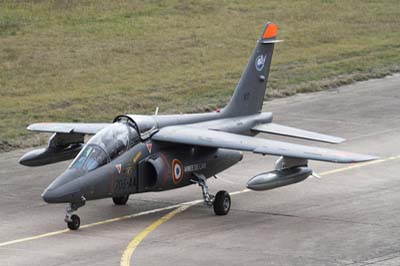 Standards must be maintained
Standards must be maintained
The post flight briefing back at the Squadron, review the timings, the IP will mark the flight from 0-20, the average mark expected is twelve. If the student falls below the average there are three revision flights. The marking is done according to certain criteria, such as; target management, low-level management and cockpit attitude. For 25 year old student pilot Ltt C Jolly the debriefing is of more use than the mark itself; “It is important to know what the IP thinks of our capabilities we want to know where we can improve”. The day finishes for the student by going over instruction books and manuals to cover the areas highlighted by the IP ready for the next flight.
Staff assigned to the Standards and Evaluation (STANEVAL 4/11 ‘Jura’) Squadron at Tours will regularly test the IP’s to make sure they are marking correctly to ensure they are not too easy or too tough. Maj Rey admitted; “There is always a subjective element to marking but we try to standardise”.
What's next?
Staff will work hard to prepare students for the next stage of their development and achieve their dream to become a jet fighter pilot. For those few students that fail to make the grade then most will be put onto transport aircraft and helicopter training courses. The successful students will move to Ecole de transition Opérationnelle (ETO 008) with AJeTS at Cazaux (BA 120) for continuity training on the Alpha Jet, where they go further with navigational training and weapon delivery. At Tours the student advises the IP during the training flight if he is early or late whereas at Cazaux the student has to match the flight timings with the reference time on the flight plan. With basic tactical scenarios and time on targets (TOT) of plus or minus 30 seconds, the work in the cockpit is ramped up. Eventually these same students may return from their frontline squadron and become instructors and impart their considerable knowledge and experience to the next generation of students. |
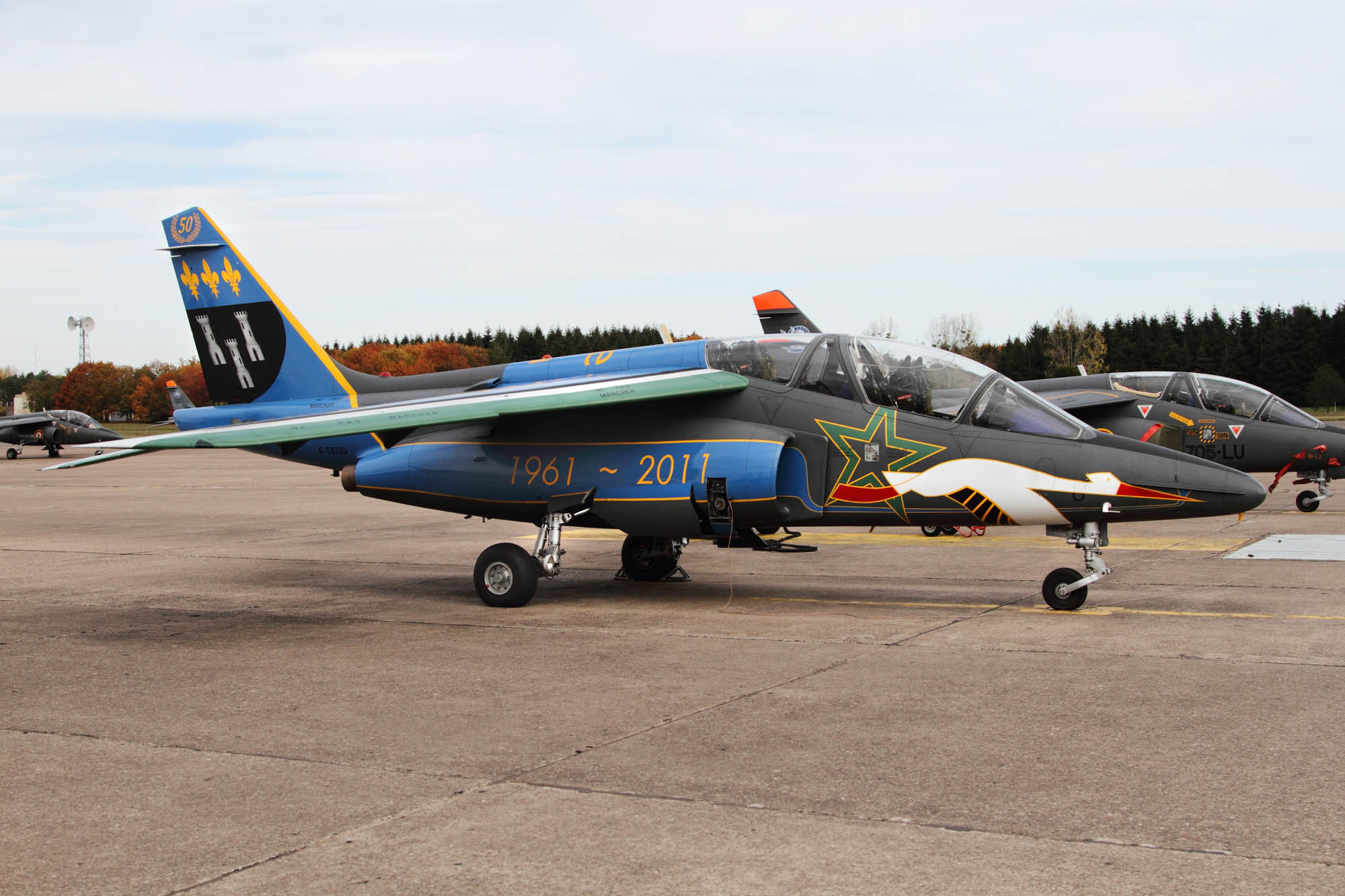 |
In June 2011 the Ecole de l'Aviation de Chasse commemorated 50 years of pilot training at Base Aérienne 705 Tours-St. Symphorien they specially painted a jet for the occasion.
Unusually Alpha Jet E (E107 coded '314-UD' but not applied) has its callsign F-TEUD painted on the fuselage. |
| Around Base Aérienne 705 Tours-St.Symphorien |
The Dassault/Dornier Alpha Jet is a light attack and advanced jet trainer which was co-manufactured by Dornier of Germany and Dassault-Bréguet of France, the first flight took in 1978. The Armée de l' Air took delivery of 176 Alpha Jet Es ('E' for École or School) starting in 1979.
The main ramp at Tours. |
| Left to right: Alpha Jet Es (E45 '705-TF', E104 '705-TG' with E112 '705-AO', E153 '705-RU' and E51 '705-AD'). |
| Left to right: Alpha Jet Es (E151 '705-FD', E129 '705-LP' and E137 '705-LJ'). |
| Alpha Jet E (E17 '705-AA') fitted with drop tanks. |
| Left to right: Alpha Jet Es (E137 '705-LJ', E112 705-AO' and E96 '705-TC'). |
| Left to right: Alpha Jet Es (E51 '705-AD', E17 705-AA' and E75 '705-AE'). |
| Left to right: Alpha Jet Es (E45 '705-TF' and departing E128 '705-TM'). |
| Left to right: Alpha Jet Es (E128 '705-TM' and E45 '705-TF' and in the hangar E47 '705-AC', E110 '705-AH' and E58 '705-TK'). |
| Left to right: Alpha Jet Es (E48 '705-MH' and E149 '705-RS'). |
| Alpha Jet E (E104 '705-TG'). |
| Left to right: Alpha Jet Es (E123 '705-RM' and E48 '705-MH') |
| Left to right: Alpha Jet Es (E112 '705-AO', E104 '705-TG' and E123 '705-RM'). |
| Left to right: Alpha Jet Es (E75 '705-AE', E51 '705-AD' and E17 '705-AA'). |
| Left to right: Alpha Jet Es (E98 '705-MF', E25 '705-TJ', E153 705-RU' and E149 '705-RS'). |
Left to right: Visiting Dijon based Alpha Jet Es.
Alpha Jet Es (E13 '102-MM' and E87 '102-LC') and AS 350BA Ecueruil (1575 'JCS' and 2219 'JCX') of the Gendarmerie who have two helicopters based at Tours. |
| Left to right: Jaguar (A131 '11-EE') and former Tours based aircraft T-33A Shooting Star (21330 '314-UM') and MD-450 Ouragan (205 'TO'). Mirage III with the Fire Service. |

 The first jets arrive
The first jets arrive
